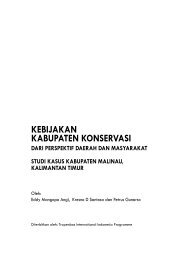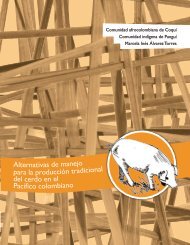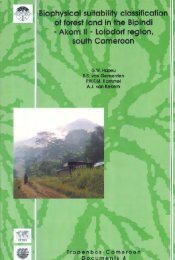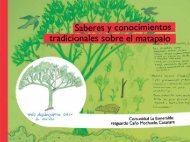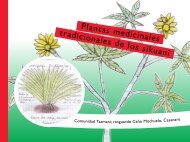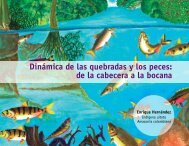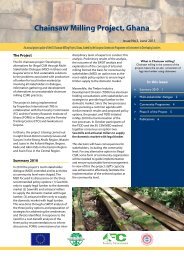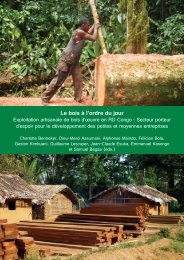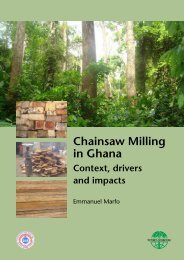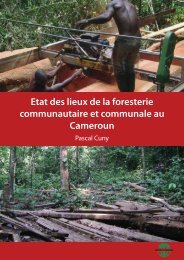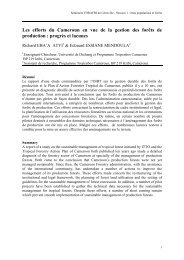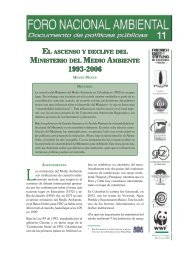Download the publication - Tropenbos International
Download the publication - Tropenbos International
Download the publication - Tropenbos International
Create successful ePaper yourself
Turn your PDF publications into a flip-book with our unique Google optimized e-Paper software.
Plant diversity in a Central African rain forest: Implications for biodiversity conservation in Cameroon<br />
Caesalpinioideae, <strong>the</strong> submontane forest on hilltops, to <strong>the</strong> mixed evergreen and<br />
semi-deciduous forest in <strong>the</strong> drier Ma’an area. This results in an increase in species<br />
richness from <strong>the</strong> coast to <strong>the</strong> hilltops and a gradual variation in dominant species,<br />
from coastal indicator species along <strong>the</strong> coast to a forest rich in Caesalpinioideae<br />
and a mixed forest rich in semi-deciduous elements.<br />
In Chapter 3, we studied <strong>the</strong> diversity patterns in <strong>the</strong> flora of <strong>the</strong> Campo-Ma’an rain<br />
forest. We tested out whe<strong>the</strong>r <strong>the</strong>re is a correlation between tree species diversity<br />
and diversity of o<strong>the</strong>r growth forms such as shrubs, herbs, and lianas in order to<br />
understand if in <strong>the</strong> context of African tropical rain forest, tree species diversity<br />
mirrors <strong>the</strong> diversity of o<strong>the</strong>r life forms or strata. Are forests that are rich in tree<br />
species also rich in o<strong>the</strong>r life forms? To answer <strong>the</strong>se questions, we analysed <strong>the</strong><br />
family and species level floristic richness and diversity of <strong>the</strong> various growth forms<br />
and forest strata within 145 plots recorded in <strong>the</strong> various vegetation types. A<br />
comparison of <strong>the</strong> diversity and species richness within forest layers and within<br />
growth forms was done using General Linear Models followed by multiple<br />
comparison tests. The results showed that tree species accounted for 46% of <strong>the</strong> total<br />
number of vascular plant species with DBH ≥ 1 cm, shrubs/small trees 39%,<br />
climbers 13% and herbs less than 1%. Only 22% of <strong>the</strong> diversity of shrubs and<br />
lianas could be explained by <strong>the</strong> diversity of large and medium sized trees, and less<br />
than 1% of herb diversity was explained by <strong>the</strong> tree diversity. The shrub layer was<br />
by far <strong>the</strong> most species rich in <strong>the</strong> different plots and vegetation types. It was<br />
significantly more diverse and species-rich than <strong>the</strong> tree and herbaceous layers.<br />
More than 82% of tree species, 90% of shrubs, 78% of lianas and 70% of<br />
herbaceous species were recorded in <strong>the</strong> shrub layer. Moreover, shrubs contributed<br />
for 38% of <strong>the</strong> 114 strict and narrow endemic plant species recorded in <strong>the</strong> area,<br />
herbs 29%, trees only 20% and climbers 11%. These results indicated that <strong>the</strong><br />
diversity of trees does not always reflect <strong>the</strong> overall diversity of <strong>the</strong> forest in <strong>the</strong><br />
Campo-Ma’an area, and <strong>the</strong>refore it may not be a good indicator for <strong>the</strong> diversity of<br />
shrubs and herbaceous species. Fur<strong>the</strong>rmore, this suggests that biodiversity surveys<br />
based solely on large and medium sized tree species (DBH ≥ 10 cm) is not an<br />
adequate method for <strong>the</strong> assessment of plant diversity because o<strong>the</strong>r growth form<br />
such as shrubs, climbers and herbs are under-represented. Therefore, inventory<br />
design based on small plots of 0.1 ha, in which all vascular plants with DBH ≥ 1 cm<br />
are recorded, is a more appropriate sampling method for biodiversity assessments<br />
than surveys based solely on large and medium sized tree species.<br />
Indicator species are usually defined as species whose status and ecology provide<br />
information on <strong>the</strong> overall condition of <strong>the</strong> ecosystem, and that reflects <strong>the</strong> quality<br />
and changes in environmental conditions. In <strong>the</strong> tropics, some of <strong>the</strong>se indicator<br />
species are used to trace <strong>the</strong> location and extend of tropical rain forest refuges<br />
because of <strong>the</strong>ir limited dispersal and colonisation abilities. In Chapter 4, we studied<br />
<strong>the</strong> distribution patterns of 178 sensitive bio-indicator forest species such as strict<br />
and narrow endemics, as well as o<strong>the</strong>r well-known slow dispersal species, to find<br />
out whe<strong>the</strong>r <strong>the</strong> entire Campo-Ma’an rain forest was part of a late Pleistocene rain<br />
forest refuge or not. The distributions patterns obtained corroborate <strong>the</strong> view of<br />
many authors who argue that during glacial times, forests were restricted to <strong>the</strong><br />
upper slopes of hills near <strong>the</strong> top, high altitude lowland forests, or along riverbanks,<br />
where <strong>the</strong>re was enough humidity for <strong>the</strong>ir survival. Our findings, <strong>the</strong>refore, do<br />
190



